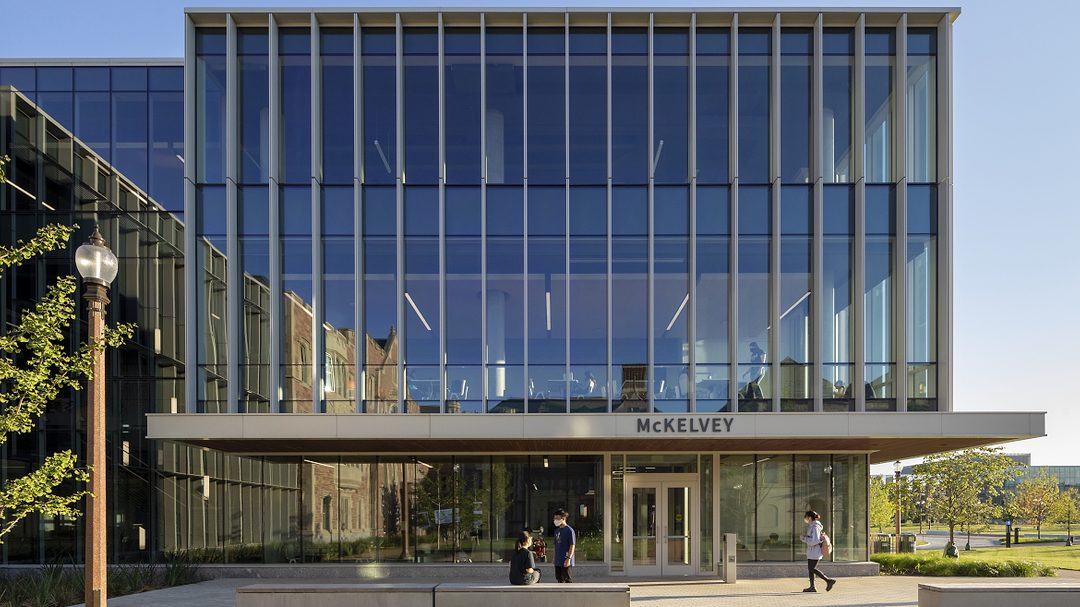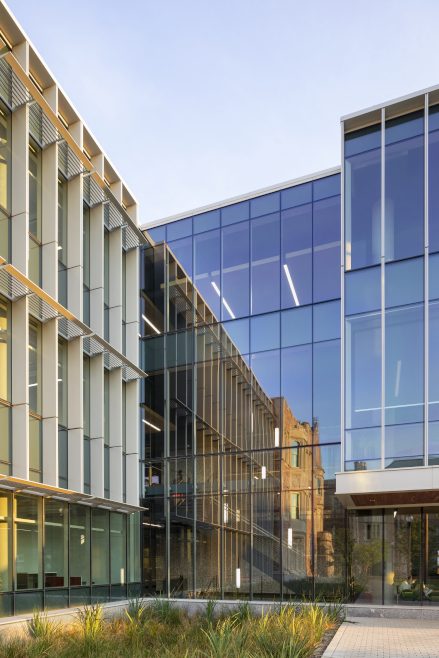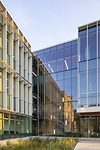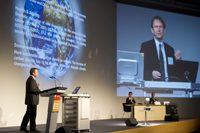WashU’s McKelvey Hall Receives Sustainability-Focused Redesign

Images courtesy of Tubelite Inc.

Images courtesy of Tubelite Inc.


Part of the largest capital project in Washington University’s (WashU’s) 125-year history, James M. McKelvey, Sr. Hall completes the final stage for the East End transformation of Danforth Campus in St. Louis, Missouri. Sustainability and occupant well-being were essential objectives for the university.
To meet the project’s numerous design goals and performance requirements, Tubelite Inc. and its representative, Doug Urich of ARCHON Fenestration Technologies, worked closely with the design and building team. In addition to Tubelite, WashU’s 86,500-square-foot McKelvey Hall project was supported with products and services from Wausau Window and Wall Systems, Viracon, and Linetec.
Going for Gold
Perkins Eastman led the design of McKelvey Hall working closely with St. Louis-based Patterhn Ives as associate architect and WashU’s facilities planning and management. As the new home of the Department of Computer Science & Engineering, McKelvey Hall is designed to be 30% more efficient than a standard building. It is on track to achieve LEED® v4 Gold certification or higher through the U.S. Green Building Council.
The project team followed an integrated design process, incorporating the principles of sustainable design with attention to energy efficiency, low-impact materials, reuse and recycling, quality and durability, and health and wellness. Every material selected for McKelvey Hall was screened against a multitude of variables, including LEED v4 requirements, Red List chemicals, healthcare-level standards outlined in the Healthier Hospitals Initiative, and the WELL Building Standard™.
Looking Forward
McKelvey Hall’s three-story structure respects WashU’s architectural legacy by incorporating Missouri red granite and limestone masonry. Bridging the Collegiate Gothic style reminiscent of European universities and carrying the campus forward, the modern aluminum-framed glass façade serves as a dramatic window into the school’s innovative, computational research and connects students with views of the surrounding campus.
To create the McKelvey Hall’s transparent and dramatic elements, ARCHON provided Tubelite’s Therml=Block™ 900RW Series Thermal Window Wall, 400T Series Thermal Curtainwall, and wide stile doors for the hall’s entrance area. Wausau supplied additional unitized curtainwall glazed with Viracon’s VNE24-63 glass.
Ensuring WashU’s and the architectural team’s expectations were met, a full-size, finished mock-up was prepared for approval prior to installation.
Energy-Efficient Elements
Helping achieve the building’s energy-efficiency criteria, Tubelite’s and Wausau’s aluminum framing members were thermally broken. Tubelite’s 900RW single and dual thermal break options allow architects and specifiers to select appropriate thermal performance levels to meet their projects’ requirements.
“Designed for clerestory and ribbon window applications in low- to mid-rise commercial buildings, Tubelite’s 900RW window wall saves installation time and labor, while meeting model energy codes and supporting LEED certification,” said Tubelite’s Senior Manager of Product Strategy, Brian Tobias, LEED AP. “Tubelite’s Therml=Block products provide superior energy and condensation resistance performance using multiple thermal barriers, while providing structural integrity and aesthetic flexibility.”
Tubelite’s products are tested per the Fenestration and Glazing Industry Alliance’s AAMA standards for air, water, structural, and condensation resistance. They also are tested and modeled for thermal transmittance per the National Fenestration Rating Council’s procedures.
“Thorough testing by an independent laboratory ensures the 400T is the highest quality curtainwall framing product the industry has to offer,” Tobias added. “Our dependable entrance systems also support smooth, reliable operation in moderate to heavy use applications, such as university buildings. The strength and flexibility of our steel tie-rod construction allow installation professionals to easily modify, disassemble or resize them at the jobsite, helping complete projects more quickly.”
Natural Light and Shading
Further enhancing performance and keeping occupants comfortable, Viracon’s high-performance ultra-clear glass was paired with Wausau’s vertical and horizontal sunshades and custom shadowboxes. The exterior shading devices were engineered as integral components with the curtainwall, as were the interior 24-inch-deep light shelves that maximize daylight more deeply into the facility’s interior.
“With attention to solar orientation and shading, ample natural light, high-performance façade design, and energy efficiency, the building promotes student productivity and well-being campus-wide,” noted Perkins Eastman.
Environmentally Responsible Finishes
Enhancing both the building’s performance and appearance, Linetec provided the thermal improvement and finishing for all of Tubelite’s and Wausau’s aluminum framing, as well as finishing the shading systems and parapet trim. “Amazing Gray” and “Noble Gray” colors were selected and applied using high-performance 70% PVDF resin-based architectural coatings.
To safely remove the VOCs in the liquid paints’ solvents, Linetec uses a 100% air capture system and regenerative thermal oxidizer. By managing this in its quality-controlled facility, there is no adverse environmental impact either at Linetec or on the jobsite. For McKelvey Hall, Linetec applied the 70% PVDF resin-based coating to meet AAMA 2605 specification, the most stringent in the industry. Following this standard, these architectural coatings are proven to withstand 4,000 hours of accelerated testing for humidity and salt spray, resist chalking, gloss loss, and chemicals. They also exhibit outstanding color retention and UV-resistance, contributing to university buildings’ cost-effective maintenance.
At the end of their long lifespan on the building, the finished aluminum framing systems can be recycled. Linetec’s environmentally responsible finishing supports LEED, WELL and other sustainable project goals.
Collaboration and Connection
Along with meeting WashU’s numerous sustainability and well-being requirements, McKelvey Hall fulfills the school's intellectual vision and academic plan. Named in honor of the Dean of the School of Engineering & Applied Science, James M. McKelvey Sr., the new facility was envisioned as a space for interdisciplinary collaboration and high-impact research.
Promoting openness and creating connections, the hall physically links the university’s schools and buildings, while fostering engagement between teachers and students. The new building includes 19,000 square feet of research space, a café, the Judith Hood McKelvey Commons, faculty and departmental offices, and shell space for future classrooms and research.
Recognized Success
McKelvey Hall was one of six new high-performance buildings totaling 713,000 square feet across 18 acres that realized WashU’s Danforth Campus East End Transformation. The coordinated campus-wide effort earned a 2021 St. Louis Business Journal Building STL Award, a 2020 Keystone Award from the American General Contractors (AGC) Missouri chapter, and a 2020 national Honor Award for Excellence in Planning from The Society for College and University Planners (SCUP).
The sweeping East End planning, design and construction project also converted nearly six acres of surface parking into green space, furthering the university’s commitment to sustainability. A greater connection between the city and community is achieved with a reimagined entrance to campus across the street from Forest Park, long considered one of the best urban public parks in the nation.
Intentional Transformation
“Not only is the East End a breathtaking and sustainable extension of the Danforth Campus; its intentional design, architecture and proximity to Forest Park signify our openness and accessibility to the wider community as well as our commitment to collaboration across departments and disciplines,” said WashU Chancellor Andrew D. Martin.
He continued, “With careful attention to these details, this transformation allows us to further our mission to pursue distinction in education and research and to be an even stronger neighbor and partner as we open our doors to the St. Louis region even wider.”
“This project was truly a unique opportunity to honor our physical heritage and lay the foundation for our future,” added Henry S. Webber, the university’s executive vice chancellor and chief administrative officer. “These world-class facilities will support world-class teaching and research and the everyday activities of our faculty, students, staff and guests for many years. I want to commend the project team at the university, our contractors and our design teams on a job very well done.”
Looking for a reprint of this article?
From high-res PDFs to custom plaques, order your copy today!







